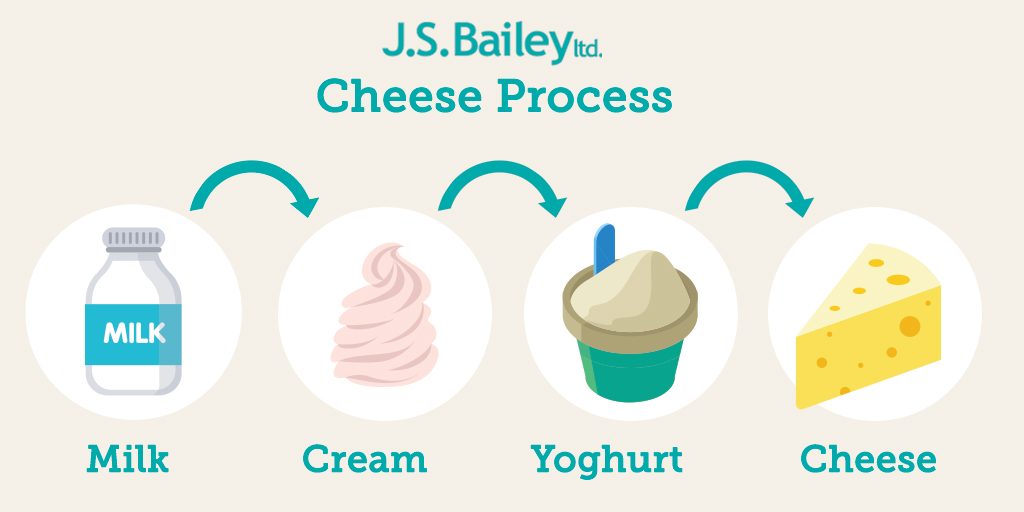Do you love cheese and all things to do with dairy? Well now is the time to get to know your milk processes and discover how milk is turned into your favourite foods, such as cream, butter, cheese and yoghurt.
Milk is an amazing product and has far more versatility than other food products. It can be turned into so many formats, which all taste completely different. Whether you love sour, sweet or savoury flavours milk can be made into a delicious edible food you will love.

How Does Milk Become Cream?
Cream isn’t actually a separate entity from milk, it is part of the milk. This means milk doesn’t really become cream it is merely part of the milk that is separated from the rest. This is quite amazing when you consider the wide variety of cream there is, including sour cream, extra thick cream and clotted cream.
Cream is the high fat part of milk. If you leave whole fat / raw milk that has not been homogenised to stand for more than 30 minutes you will noticed a faint line appear. This is because the high fat content of the milk is rising to the top because it is less dense. Fat floats. This is then skimmed off and you have cream. In modern cream manufacture centrifuge is used to make the separating process faster.
The thickness of cream will vary depending on the fat content of the milk.
Double cream or extra thick cream is made by heat treating milk then quickly cooling.
Clotted cream involves heat treating milk then cooling it more slowly so the fat rises to the surface in ‘clouts’. Sour cream and crème fraiche involve a mild form of fermentation. This process is also used in making yoghurt and cheese but to greater degrees. Fermentation adds bacteria to milk to turn lactose into lactic acid.
How Does Milk Become Butter?
Making butter essentially just requires the extensive churning (shaking up) of cream or very fatty milk.
It may sound too simple to be possible but a fascinating chemical process is taking place as milk is churned. You are actually making a fat in water emulsion become a water in fat emulsion.
So, what is actually happening to the milk when you churn it? Well as you churn the milk the membranes of fat in the cream are broken so fat droplets can more easily join together forming larger fat droplets. As churning continues these larger clumps of fat join together even more with air bubbles in between. This becomes a foam which leaks out as buttermilk. The rest becomes a thicker network of fat. Once all buttermilk is drained away butter can be frozen. It is normally then melted and refrozen into smaller segments ready to be sold.
In the UK, USA and Scandinavia we tend to add salt to butter.
How Does Milk Become Yoghurt?
Yoghurt, like sour cream and crème fraiche is made via fermentation. Bacteria including Streptococcus thermophiles, Lactobacillus bulgaricus and many others are added to milk and these bacteria feed on lactose and turn it into lactic acid. This makes the milk thicker and more sour. This is done for longer with yoghurt than sour cream but it is essentially the same process. Heating is also often used when making yoghurt as this can affect the thickness of the yoghurt.
How Does Milk Become Cheese?
Milk becomes cheese with a similar process as yoghurt. You basically let the milk go off but in a controlled environment. The choice of bacteria can have a dramatic impact on the look, taste and smell of cheese, hence the ability to produce such a wide array of cheeses. The length of fermentation also has a major impact on the type of cheese that comes to be produced.
Milk contains the proteins casein and whey which are an essential factor in the process of creating cheese.
Once the bacteria have turned the lactose to lactic acid enzymes called rennet are added. Rennet can come from certain bacteria or the stomach lining of young goats. The former method of making rennet is more common these days.
As the casein and whey proteins go off the casein curdles but the whey becomes a thin liquid.
Whey is removed and salt is added. Salt is ideal for helping the milk to firm up and to stop it spoiling in the wrong way. The curds from the casein are cut into smaller pieces and heated.
The heating releases even more whey which is also removed. The result is solid lumps of casein. These are pressed into moulds and left to dry for varying amounts of time depending on the type of cheese you are trying to make.

